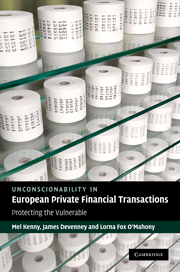Book contents
- Frontmatter
- Contents
- List of contributors
- Introduction: conceptualising unconscionability in Europe
- PART I Conceptualising unconscionability
- PART II Conceptualising unconscionability in financial transactions
- Conclusions
- 19 Conceptualising unconscionability in Europe: in the kaleidoscope of private and public law
- Index
- References
19 - Conceptualising unconscionability in Europe: in the kaleidoscope of private and public law
from Conclusions
Published online by Cambridge University Press: 06 August 2010
- Frontmatter
- Contents
- List of contributors
- Introduction: conceptualising unconscionability in Europe
- PART I Conceptualising unconscionability
- PART II Conceptualising unconscionability in financial transactions
- Conclusions
- 19 Conceptualising unconscionability in Europe: in the kaleidoscope of private and public law
- Index
- References
Summary
Introduction
The aim of this project has been to explore particular conceptions of, and responses to, unconscionability and similar notions, with specific reference to financial transactions across Europe. Such an endeavour is difficult for at least five reasons.
First, the process can be obscured by the nuances of emphasis and language both within jurisdictions and at a pan-European level. Secondly, as the chapter by Waddams suggests, particular jurisdictions may choose, to varying degrees, to respond (sometimes indirectly) to unconscionability issues through a variety of devices rather than through an independent doctrine of unconscionability. Thirdly, as we have suggested elsewhere, conceptions of, and responses to, unconscionability may be shaped by, for example, the social security and insolvency regimes within a particular jurisdiction. Fourthly, as Capper demonstrates, conceptions of unconscionability may be dependent on context and, as Swain and Fairweather clearly demonstrate, may vary over time. Indeed a week after the conference upon which this collection of essays is based, Lehman Brothers collapsed and the landscape of financial transactions and many of the assumptions underlying traditional approaches to the protection of the vulnerable in financial transactions was radically challenged; our perception of risk, attitudes towards regulation and understandings of risk may never be the same again. As Capper demonstrates, even within particular jurisdictions conceptions of unconscionability can be contested. Indeed Waddams thought-provokingly suggests that unconscionability ‘has had multiple dimensions, and that it has not been confined to a single conceptual category’.
- Type
- Chapter
- Information
- Unconscionability in European Private Financial TransactionsProtecting the Vulnerable, pp. 377 - 399Publisher: Cambridge University PressPrint publication year: 2010
References
- 3
- Cited by

